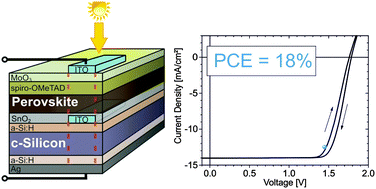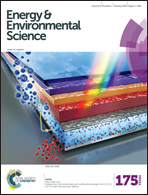Monolithic perovskite/silicon-heterojunction tandem solar cells processed at low temperature†
Abstract
Tandem solar cells combining silicon and perovskite absorbers have the potential to outperform state-of-the-art high efficiency silicon single junction devices. However, the practical fabrication of monolithic silicon/perovskite tandem solar cells is challenging as material properties and processing requirements such as temperature restrict the device design. Here, we fabricate an 18% efficient monolithic tandem cell formed by a silicon heterojunction bottom- and a perovskite top-cell enabling a very high open circuit voltage of 1.78 V. The monolithic integration was realized via low temperature processing of the semitransparent perovskite sub-cell where an energetically aligned electron selective contact was fabricated by atomic layer deposition of tin oxide. The hole selective, transparent top contact was formed by a stack of the organic hole transport material spiro-OMeTAD, molybdenum oxide and sputtered indium tin oxide. The tandem cell design is currently limited by the photocurrent generated in the silicon bottom cell that is reduced due to reflectance losses. Based on optical modelling and first experiments, we show that these losses can be significantly reduced by combining optical optimization of the device architecture including light trapping approaches.


 Please wait while we load your content...
Please wait while we load your content...